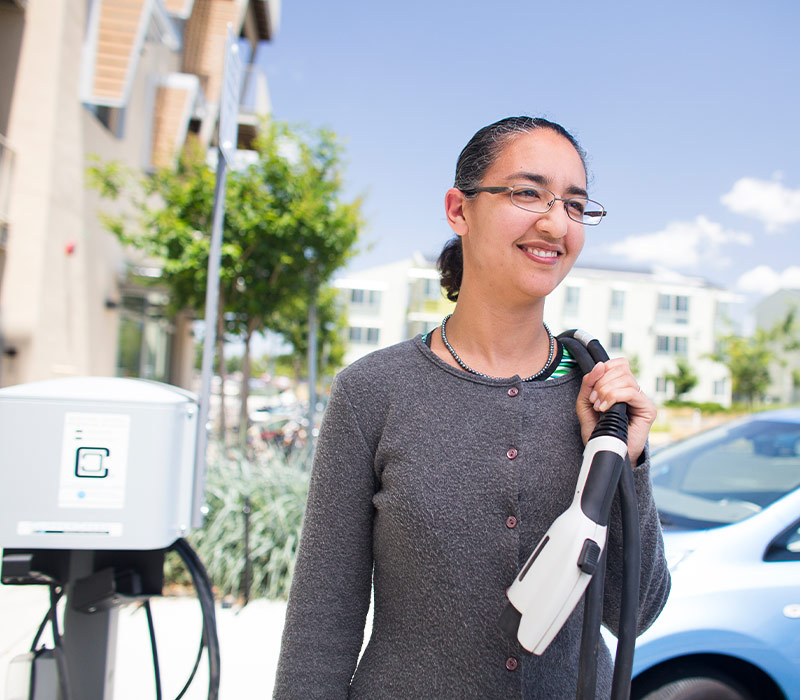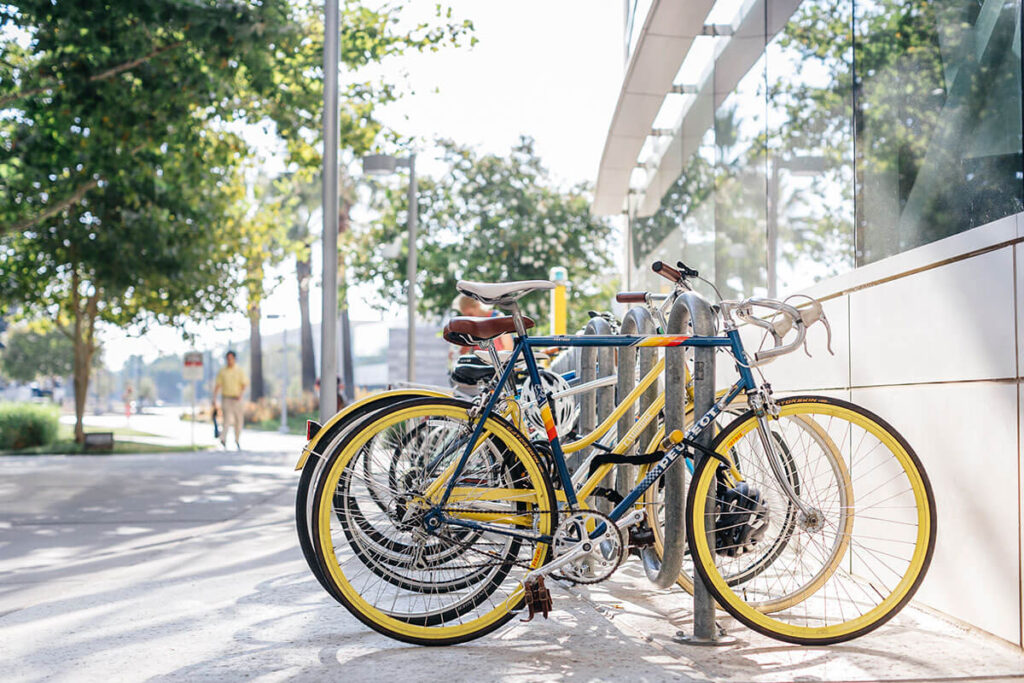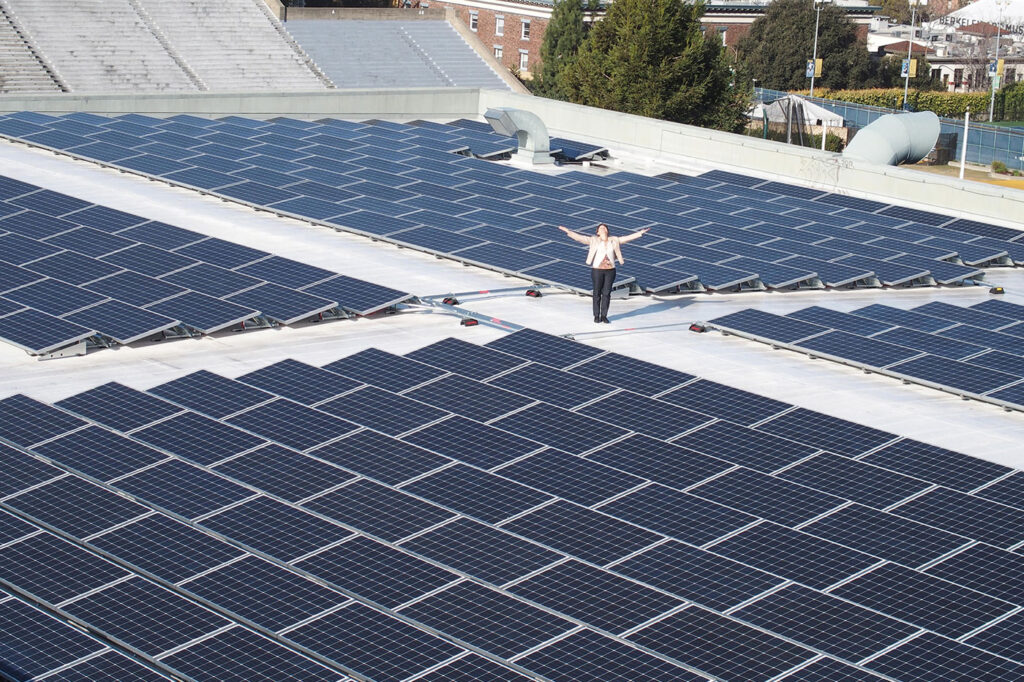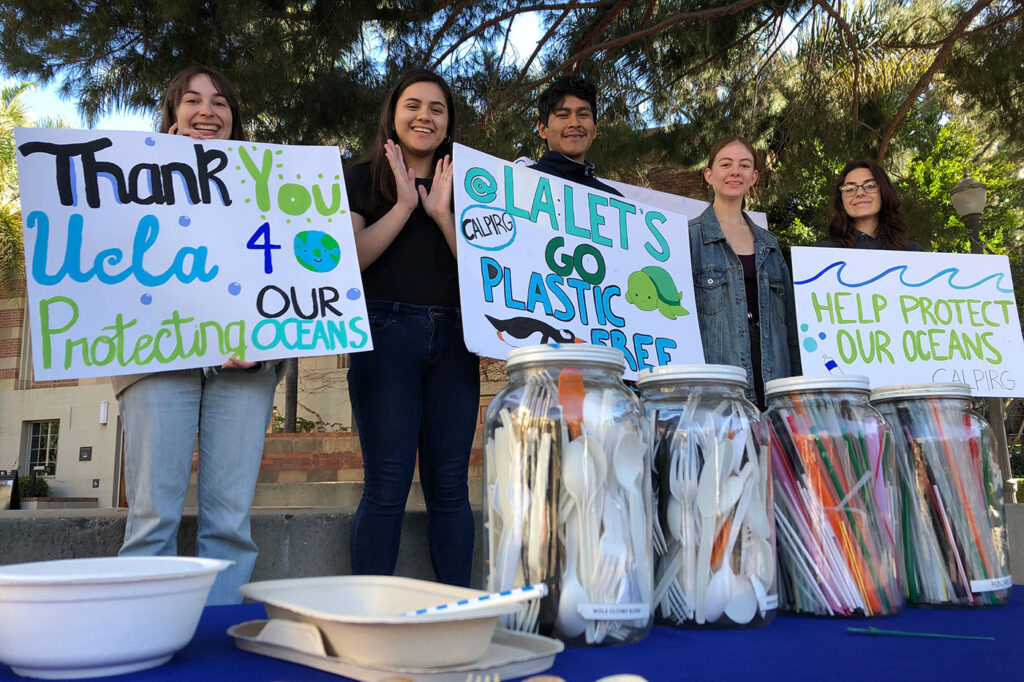Commitment
The 2021 Annual Report on Sustainable Practices explores the issue of climate justice, in recognition of how the impacts of climate change are falling disproportionately on vulnerable communities.

Letter from
the President
Over the past year, the University of California remained steadfast in our commitment to sustainability despite the profound challenges and uncertainty of a global pandemic. Thanks to the leadership and hard work of UC faculty, staff and students, we continue to reach new milestones as we work to achieve and support sustainability in our operations, research, procurement, investments and more.
This is a pivotal moment in the global climate crisis. The most recent report from the Intergovernmental Panel on Climate Change, released this summer, provided new insights into the dire impacts of a 1.5 degrees Celsius increase in global temperature. It also underscored the importance of recognizing the disproportionate impacts of climate change on disadvantaged communities around the globe, and ensuring that our adaptations to global warming provide support and justice for these vulnerable populations.
At UC, we took new steps to engage even more deeply on this issue in 2021. We launched the UC Center for Climate Justice, one of the first university-based institutions dedicated to equitable climate action in the country, and the UC Center for Climate, Health and Equity, which will advance equitable and just climate solutions that promote human health. These hubs will accelerate critical research at the intersection of climate change, social justice and health inequities.
We also continued to use our campuses as living laboratories for the development of bold new climate solutions. In 2021, UC’s Energy Efficiency Partnership program reached a milestone of $100 million in incentive payments from California utilities. This helped our campuses and medical centers reduce energy costs and make our buildings safer and more comfortable. The U.S. Environmental Protection Agency also recognized the University’s efforts with a Green Power Leadership Award and ranked UC #1 among all colleges and universities for our green power use.
Though we have much more work to do, we are proud of this progress toward achieving our ambitious goals around sustainability, climate action and climate justice. Through our collaboration, creativity and perseverance, we can continue to accelerate UC’s efforts across our research, education and operations, and combat global climate disruption in California and around the world.

Michael V. Drake, MD
President, University of California

Letter from the
AVP of Capital Programs,
Energy & Sustainability
“Because of COVID…”
How many times over the past two years have we heard this phrase inserted into our conversations to explain why so many aspects of our lives have been temporarily disrupted or permanently changed? For the 2021 Annual Sustainability Report, we must join that chorus. Nearly every one of our operational metrics must be footnoted with “because of COVID…” to help explain why our 2020 and 2021 data shows shifts from historical trends and anticipated outcomes.
Unusual results were to be expected given that most of UC’s classes remained online, buildings were not fully occupied, large events were canceled, and many dining establishments stayed closed. At the same time, data collected during this unprecedented period can provide many helpful insights to guide future actions. For example, who would have guessed that UC’s energy use during the pandemic in 2020 would be only about 7% lower? Can we do better than that? What would we need to change?
We’ve learned that significant resources are needed to keep our campuses running even when our populations are significantly reduced. Take campus exteriors, for example. Our trees and landscaping still needed the same amount of water, and we continued to keep our streets and public spaces lit each night even though fewer people were on campus. Because of COVID, our sustainability data this year includes many anomalies. However, we’ve made the decision to report this data transparently so that all of us can better understand how reduced campus operations did or did not affect sustainability performance.
The other phrase we heard much more frequently in 2021 was “because of climate change,” and climate-related concerns were a prompt for this year’s annual sustainability report focused on climate justice. The massive wildfires and air pollution in California in 2021 continued to remind us of the urgency of tackling climate change and addressing the health effects on low-income communities, the elderly, children and others who are more vulnerable in our society.
UC has begun to take action on climate justice as the start of a long journey that will require both introspection and action. In 2021, staff working on sustainability at UC acknowledged in a statement that the impacts of climate change will be felt disproportionately by vulnerable communities and outlined a commitment to examine UC’s sustainability goals (as well as its staffing and programming) with a diversity, equity and inclusion lens. Additionally, UC’s campuses are working with their students and local communities on adaptation strategies.
As UC locations adjust and learn from the ongoing presence of COVID-19 and climate change, UC continues to examine how its sustainability goals and metrics should evolve and adapt. I’m hopeful that future annual reports will be able to note that the lessons learned “because of COVID” and from the early impacts of climate change led the University of California to redouble its efforts in creating a more equitable, sustainable world.
Thank you for reading,

David Phillips
Associate Vice President, Capital Programs, Energy & Sustainability
Policy Areas
The University of California’s sustainability commitment began in 2003 with a Regental action that led to the adoption of the Presidential Policy on Green Building Design and Clean Energy Standards in 2004. Since adopting that policy, UC has expanded the scope of the Sustainable Practices Policy to include climate protection, transportation, sustainable building operations, zero waste, procurement, food, water, health and well-being, and health care facilities.

The Sustainable Practices Policy includes all 10 campuses, six academic health centers, UC Agriculture and Natural Resources, Lawrence Berkeley National Laboratory and the UC Office of the President.
The UC Policy on Sustainable Practices can be accessed online, and a summary is available below. UC’s Sustainability Data summarizes progress toward the goals:
Climate
- All campuses, including their health systems, will reduce greenhouse gas emissions to year 1990 levels by 2020.
- All campuses, including their health systems, will achieve climate neutrality from scope 1 and 2 sources by 2025.
- All campuses, including their health systems, will achieve climate neutrality from specific scope 3 sources (as defined by Second Nature’s Climate Commitment) by 2050 or sooner.
Energy
- Energy efficiency: Reduce each location’s energy use intensity by an average of at least 2% annually.
- Clean electricity: Obtain 100% clean electricity at each campus and health location by 2025. By 2018, the University’s Clean Power Program will provide 100% clean electricity to participating locations.
- On-campus combustion: Increase biogas combustion to at least 40% of on-site natural gas combustion at each campus and health location by 2025.
Food Service
- Procure 25% sustainable food as defined by the Association for the Advancement of Sustainability in Higher Education’s Sustainability Tracking, Assessment and Rating System (AASHE STARS) at each campus and 30% sustainable food as defined by Practice Greenhealth at each health system by 2030.
- Develop a plant-forward menu goal.
General Sustainability Performance Assessment
All undergraduate campuses must achieve an Association for the Advancement of Sustainability in Higher Education’s Sustainability Tracking, Assessment and Rating System’s (AASHE STARS) Silver rating and strive for Gold by 2023.
Green Building
New Buildings and Renovations
- Design and construct all new buildings and major renovations to a minimum LEED BD+C (Building Design and Construction) Silver rating and meet the prerequisites of the Laboratories for the 21st Century Environmental Performance Criteria.
- Design and construct other renovation projects (except acute care facilities) with a cost over $5 million (CCCI 5000) to a minimum LEED ID&C (Interior Design and Construction) certified rating.
- Energy-efficient design:
- Acute care/hospital facilities and medical office buildings: Outperform the American Society of Heating, Refrigerating and Air-Conditioning Engineers (ASHRAE) standard 90.1-2010 by at least 30% or meet UC’s whole-building energy performance targets.
- All other buildings: Outperform the energy requirements of the California Building Code by at least 20% on all new construction and major renovation projects or meet UC’s whole-building energy targets.
- Prohibit on-site fossil fuel combustion (e.g., natural gas) for space or water heating in all new buildings and major renovation projects (except those projects connected to an existing campus central thermal infrastructure) approved after June 30, 2019.
Existing Building Operations and Maintenance (EBOM)
- Seek to certify as many buildings as possible through the LEED EBOM rating system at each campus.
Health and Well-Being
By the end of 2022, the UC Healthy Campus Network will review the strengths and gaps in the UC Sustainable Practices Policy and make recommendations for integration based on:
- Environmental and human health co-benefits.
- Social, physical and emotional well-being.
- Health equity.
Procurement
- Achieve full compliance with required level green spend criteria per product category; target to be reached within three fiscal years after a category is added to the Sustainable Procurement Guidelines.
- Reach 25% preferred level green spend per product category; target to be reached within three fiscal years after a category is added to the Sustainable Procurement Guidelines.
- Reach 25% economically and socially responsible spend; target to be reached within five fiscal years of adoption of this section in the Sustainable Procurement Guidelines.
- Allocate a minimum of 15% of the points utilized in competitive solicitation evaluations to sustainability criteria.
Sustainable Building Operations and Labs
- Implement an ongoing Green Labs assessment program and assess three research groups at each campus.
- Identify existing single-pass cooling systems and constant-flow sterilizers and autoclaves in laboratories and develop a plan for replacement at each campus.
Transportation
Fleet
- Each UC location will purchase at least 50% zero-emission or hybrid vehicles when making new light-duty vehicle acquisitions by 2025.

Commute
Each location shall strive to:
- Reduce its percentage of employees and students commuting by single-occupancy vehicles (SOVs) by 10% relative to its 2015 SOV commute rates by 2025.
- Have no more than 40% of its employees and no more than 30% of all employees and students commuting to the location by SOV by 2050.
- Have at least 4.5% of commuter vehicles be ZEV by 2025.
- Have at least 30% of commuter vehicles be ZEV by 2050.
UC Health
Each health system will:
- Obtain 100% clean electricity by 2025.
- Adopt energy performance targets for acute care centers and medical office buildings.
- Maintain membership in Practice Greenhealth, a nonprofit dedicated to health care sustainability, and submit annual sustainability data for awards.
- Achieve a target of 25 pounds of total waste as defined by Practice Greenhealth per adjusted patient day by 2025 and strive for 20 pounds of total waste per adjusted patient day by 2030.
- Reduce growth-adjusted potable water consumption 20% by 2020 and 36% by 2025, when compared to a three-year average baseline of fiscal year 2005–06, fiscal year 2006–07 and fiscal year 2007–08.
- Procure 30% sustainable food as defined by Practice Greenhealth.
Water
- Reduce growth-adjusted potable water consumption by 20% by 2020 and 36% by 2025, when compared to a three-year average baseline of fiscal year 2005–06, fiscal year 2006–07 and fiscal year 2007–08 at each location.
Zero Waste
- Divert 90% of municipal solid waste from the landfill at each campus.
- Reduce per capita municipal solid waste generation to 25% below fiscal year 2015–16 levels by 2025, and 50% below fiscal year 2015–16 levels by 2030 at each campus.
- Reduce and eliminate single-use plastics items such as bags, foodware accessory items and beverage bottles.
- Prohibit the sale, procurement and distribution of packaging foam by 2020.
Timeline of Sustainability
For many decades, the University of California has been committed to sustainability in its operations.
1970-99
1970
- UC Santa Barbara creates Environmental Studies Program
1971
- UC Santa Cruz establishes Student Farm
1977
- UC Davis Student Farm opens
1998
- UC issues policy on Trademark Licensing Code of Conduct providing guidance on how workers should be treated to companies granted permission to use the University’s name
1999
- UC Santa Barbara students approve student fee to create Coastal Fund
2000-09
2002
- UC’s first LEED certification, UC Santa Barbara’s Bren School, is also the first LEED Platinum laboratory building in the world
2004
- California Student Sustainability Coalition launches Education for Sustainable Living Program
- President Dynes issues policy on Green Building Design and Clean Energy Standards
2006
- The Green Initiative Fund referendum passes at UC Santa Barbara
- UC amends Sustainable Practices Policy to include transportation, building renovation, operations, waste management and procurement
2007
- All 10 UC chancellors sign the American College and University Presidents’ Climate Commitment
2009
- Sustainable food service section added to Sustainable Practices Policy
2010-19
2012
- Goal of installing 10 MW of on-campus renewable energy met two years early
- 100th LEED certification
2013
- President Napolitano announces the Carbon Neutrality Initiative, committing UC to carbon neutrality by 2025
2014
- President Napolitano announces the Global Food Initiative
- UC becomes the first university in the world to sign the United Nations Principles for Responsible Investing
2015
- Bending the Curve Carbon Neutrality Research Summit
- UC commits to invest $1 billion in clean and renewable energy over five years
- UC publishes Framework for Sustainable Investing
- UC sells investments in companies with major revenue from tar sands or thermal coal
2016
- UC signs on to Task Force on Climate-related Financial Disclosures (TCFD)
- UC begins documenting annual carbon footprint of public equities holdings
2017
- Largest solar purchase by any U.S. university (80 MW) comes online

2018
- UC Health sustainability section added to Sustainable Practices Policy
- 300th LEED certification
- UC Regents vote to make Environmental, Social and Corporate Governance (ESG) part of the UC Investment Policy
2019
- UC’s internal power company is carbon neutral
- UC General Endowment Pool sells investments in companies that own fossil fuel reserves
- UC recognized as the top college/university in the U.S. EPA’s Green Power Partnership rankings
2020-50
2020
- UC attains $1 billion in cumulative clean energy investments
- UC investment portfolios are free of fossil fuel reserve owning assets after the sale of more than $1 billion in assets from its pension, endowment and working capital pools
- UC Merced becomes the first public research university in the country to achieve carbon neutrality
- Report and Recommendations on the Use of Herbicides and Other Pesticides completed
- 20% sustainable food procurement goal met systemwide
- UC adopts policy to phase out single-use plastics
2021
- UC Center for Climate Justice launches
- UC’s Energy Efficiency Partnership marks $100 million in incentives received from utility companies since the program launched in 2004
- UC receives EPA Green Power Leadership Award
- UC adopts Small Business Forward Policy

2025
- Carbon neutrality goal (scopes 1 and 2) to be met
- Campuses to reduce per capita potable water use by 36%
2030
- 25% sustainable food procurement goal for campuses and 30% sustainable food procurement goal for health systems to be met
2050
- Carbon neutrality goal (scope 3) to be met
 Sustainability Annual Report 2021
Sustainability Annual Report 2021